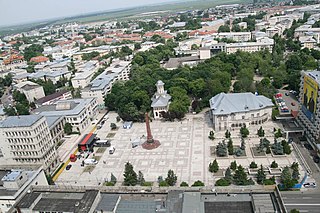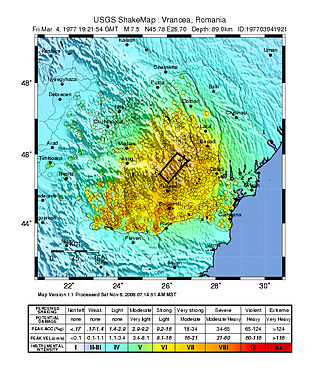The Modified Mercalli intensity scale measures the effects of an earthquake at a given location. This is in contrast with the seismic magnitude usually reported for an earthquake.

Vrancea is a county (județ) in Romania, with its seat at Focșani. It is mostly in the historical region of Moldavia but the southern part, below the Milcov River, is in Muntenia.

Focșani is the capital city of Vrancea County in Romania on the banks the river Milcov, in the historical region of Moldavia. As of 2022, it has a population of 66,719.

The 1977 Vrancea earthquake occurred on 4 March 1977, at 21:22 local time, and was felt throughout the Balkans. It had a magnitude of 7.5, making it the second most powerful earthquake recorded in Romania in the 20th century, after the 10 November 1940 seismic event. The hypocenter was situated in the Vrancea Mountains, the most seismically active part of Romania, at a depth of 85.3 km.

The Battle of Mărășești was the last major battle fought by the Central Powers against the Kingdom of Romania and Russia on the Romanian front during World War I. Romania was mostly occupied by the Central Powers, but the Battle of Mărășești kept the northern region of the country free from occupation.

Leopoldina Bălănuță was a Romanian actress.

Carlton Bloc was a residential block located in Bucharest, Romania, at 9 Nicolae Bălcescu Boulevard, completed in October 1936. Having 14 floors and a height of 47 metres (154 ft), it was the tallest building in the capital until it completely collapsed in 1940 in an earthquake.
Striking central Romania on August 30 at 21:28 UTC, the 1986 Vrancea earthquake killed more than 150 people, injured over 500, and damaged over 50,000 homes. The second largest earthquake in the area since the modernization of earthquake monitoring devices, it was felt north to Poland and south to Italy and Greece. The death toll makes it the second deadliest earthquake to occur in 1986 worldwide, after major seism of San Salvador that took the lives of almost 1,500 people.
The 1802 Vrancea earthquake occurred in the Vrancea Mountains of today's Romania on 26 October [O.S. 14 October] 1802, on St. Paraskeva's Day. With an estimated intensity of 7.9 on the moment magnitude scale, it is the strongest earthquake ever recorded in Romania and one of the strongest in European history. It was felt across an area of more than two million square kilometers in Eastern Europe and the Balkans, from Saint Petersburg to the Aegean Sea.
Recent advances are improving the speed and accuracy of loss estimates immediately after earthquakes so that injured people may be rescued more efficiently. "Casualties" are defined as fatalities and injured people, which are due to damage to occupied buildings. After major and large earthquakes, rescue agencies and civil defense managers rapidly need quantitative estimates of the extent of the potential disaster, at a time when information from the affected area may not yet have reached the outside world. For the injured below the rubble every minute counts. To rapidly provide estimates of the extent of an earthquake disaster is much less of a problem in industrialized than in developing countries. This article focuses on how one can estimate earthquake losses in developing countries in real time.
The 1838 Vrancea earthquake struck the western part of Vrancea County on 23 January with a magnitude of 7.5. The seism caused extensive damage in Moldavia and Wallachia, and killed dozens of people. The earthquake occurred just 36 years after another earthquake of magnitude over 7 on Richter scale devastated the southern part of Wallachia.

The 1990 Vrancea earthquakes were three earthquakes on 30 and 31 May 1990 with magnitudes of 7.0 and 6.2 Mw that struck the Romanian county of Vrancea, on two consecutive days. Severe damage in the Bucharest-Brăila-Brașov area was reported and dozens of casualties in Romania and neighbouring Moldova, Ukraine and Bulgaria.
The 1738 Vrancea earthquake occurred on 11 June [O.S. 31 May] 1738, during the third rule of Constantin Mavrocordat. The seism aroused great panic and is mentioned in several sources. It occurred in the lower lithospheric block, at a depth of 130 km (81 mi). Its effects were violent on large areas, the hardest hit being Bucharest, where several houses and churches collapsed.

The 2014 Vrancea earthquake struck Vrancea County on 22 November 2014 at , with a moment magnitude of 5.7. The earthquake occurred at a depth of 39 kilometers and lasted for thirty seconds. On the Mercalli scale the quake registered an intensity of VI (Strong).
The 1886 Peloponnese earthquake occurred at 23:27 local time on 27 August. It had an estimated magnitude between 6.8 and 7.3 on the moment magnitude scale and a maximum felt intensity of X (Extreme) on the Mercalli intensity scale. It caused extensive damage in Messenia, with the towns of Filiatra and Marathos both severely affected. Between 326 and 600 people were killed. It was felt over a wide area from the Khedivate of Egypt to Malta and possibly as far away as Bern and Marseille.
The 2021 Luxian earthquake was a damaging seismic event occurring in the early hours of September 16 at 04:33 China Standard Time. The surface-wave magnitude (Ms ) 6.0 or moment magnitude (Mw ) 5.4 earthquake struck at a shallow depth of 7.5 km and severe shaking in an area of 4,000 square kilometers was assigned a maximum intensity of VIII on the China seismic intensity scale. Three people were killed and 146 injured when the earthquake struck Lu County, Luzhou, Sichuan Province. At least 36,800 buildings were affected, 7,800 of them seriously damaged or completely destroyed, causing about a quarter of a billion dollars worth of damage.
The 1895 Charleston earthquake, also known as the Halloween earthquake, occurred on October 31, at 05:07 CST near Charleston, Missouri. It had an estimated moment magnitude of 5.8–6.6 and evaluated Modified Mercalli intensity of VIII (Severe). The earthquake caused substantial property damage in the states of Missouri, Illinois, Ohio, Alabama, Iowa, Kentucky, Indiana, and Tennessee. Shaking was widespread, being felt across 23 states and even in Canada. At least two people died and seven were injured.










